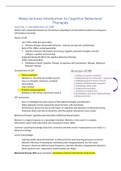College aantekeningen
Notes lectures Introduction to Cognitive Behavioral Therapies (PSB3E-KP07)
- Instelling
- Rijksuniversiteit Groningen (RuG)
Lecture notes of all the lectures (14 in total) given during the third year course Introduction to Cognitive Behavioral Therapies (PSB3E-KP07) at the University of Groningen. The parts that discussed personal information are not included due to privacy reasons.
[Meer zien]




